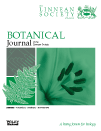-
Views
-
Cite
Cite
CLAIRE COONEY-SOVETTS, ROLF SATTLER, Phylloclade development in the Asparagaceae: an example of homoeosis, Botanical Journal of the Linnean Society, Volume 94, Issue 3, April 1987, Pages 327–371, https://doi.org/10.1111/j.1095-8339.1986.tb01053.x
Close - Share Icon Share
Abstract
Phylloclades are traditionally defined as flattened, determinate, leaf-like stems primarily on the basis of their axillary position. However, because the literature is replete with controversy over the morphological interpretation of these organs, a study of phylloclade development in comparison with leaf and stem development was undertaken in four closely related species of the Asparagaceae: Ruscus aculeatus, Danae racemosa, Semele androgyna and Asparagus densiflorus. Results reveal a continuum in phylloclade development from very leaf-like forms, such as those of Danae, via the more intermediate types of Ruscus, to the gradually more shootlike forms of Semele and Asparagus. This continuum results from a differential expression of stem (or shoot) and leaf characteristics in an axillary position. When stem (or shoot) and leaf features are combined, as in the fertile phylloclade of Ruscus, an intermediate organ is formed. Phylloclades are a form of evolutionary novelty that exemplifies the phenomenon of homoeosis, which is the transference of features from one organ to another. Developmentally, this means that leaf features are expressed by the axillary meristem.




